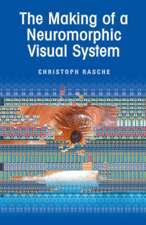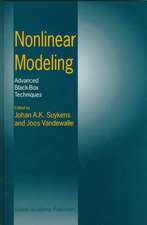Artificial Neural Networks for Modelling and Control of Non-Linear Systems
Autor Johan A.K. Suykens, Joos P.L. Vandewalle, B.L. de Mooren Limba Engleză Hardback – 31 dec 1995
The book presents both classical and novel network architectures and learning algorithms for modelling and control. Topics include non-linear system identification, neural optimal control, top-down model based neural control design and stability analysis of neural control systems. A major contribution of this book is to introduce NLq Theory as an extension towards modern control theory, in order to analyze and synthesize non-linear systems that contain linear together with static non-linear operators that satisfy a sector condition: neural state space control systems are an example. Moreover, it turns out that NLq Theory is unifying with respect to many problems arising in neural networks, systems and control. Examples show that complex non-linear systems can be modelled and controlled within NLq theory, including mastering chaos.
The didactic flavor of this book makes it suitable for use as a text for a course on Neural Networks. In addition, researchers and designers will find many important new techniques, in particular NLqTheory, that have applications in control theory, system theory, circuit theory and Time Series Analysis.
| Toate formatele și edițiile | Preț | Express |
|---|---|---|
| Paperback (1) | 942.31 lei 6-8 săpt. | |
| Springer Us – 7 dec 2010 | 942.31 lei 6-8 săpt. | |
| Hardback (1) | 949.42 lei 6-8 săpt. | |
| Springer Us – 31 dec 1995 | 949.42 lei 6-8 săpt. |
Preț: 949.42 lei
Preț vechi: 1157.82 lei
-18% Nou
Puncte Express: 1424
Preț estimativ în valută:
181.70€ • 188.99$ • 149.100£
181.70€ • 188.99$ • 149.100£
Carte tipărită la comandă
Livrare economică 12-26 aprilie
Preluare comenzi: 021 569.72.76
Specificații
ISBN-13: 9780792396789
ISBN-10: 0792396782
Pagini: 235
Ilustrații: XII, 235 p.
Dimensiuni: 156 x 234 x 20 mm
Greutate: 0.56 kg
Ediția:1996
Editura: Springer Us
Colecția Springer
Locul publicării:New York, NY, United States
ISBN-10: 0792396782
Pagini: 235
Ilustrații: XII, 235 p.
Dimensiuni: 156 x 234 x 20 mm
Greutate: 0.56 kg
Ediția:1996
Editura: Springer Us
Colecția Springer
Locul publicării:New York, NY, United States
Public țintă
ResearchCuprins
1 Introduction.- 1.1 Neural information processing systems.- 1.2 ANNs for modelling and control.- 1.3 Chapter by Chapter overview.- 1.4 Contributions.- 2 Artificial neural networks: architectures and learning rules.- 2.1 Basic neural network architectures.- 2.2 Universal approximation theorems.- 2.3 Classical paradigms of learning.- 2.4 Conclusion.- 3 Nonlinear system identification using neural networks.- 3.1 From linear to nonlinear dynamical models.- 3.2 Parametrization by ANNs.- 3.3 Learning algorithms.- 3.4 Elements from nonlinear optimization theory.- 3.5 Aspects of model validation, pruning and regularization.- 3.6 Neural network models as uncertain linear systems.- 3.7 Examples.- 3.8 Conclusion.- 4 Neural networks for control.- 4.1 Neural control strategies.- 4.2 Neural optimal control.- 4.3 Conclusion.- 5 NLq Theory.- 5.1 A neural state space model framework for neural control design.- 5.2 NLq systems.- 5.3 Global asymptotic stability criteria for NLqs.- 5.4 Input/Output properties — l2 theory.- 5.5 Robust performance problem.- 5.6 Stability analysis: formulation as LMI problems.- 5.7 Neural control design.- 5.8 Control design: some case studies.- 5.9 NLqs beyond control.- 5.10 Conclusion.- 6 General conclusions and future work.- A.1 A generalization of Chua’s circuit.- B Fokker-Planck Learning Machine for Global Optimization.- B.1 Fokker-Planck equation for recursive stochastic algorithms.- B.2 Parametrization of the pdf by RBF networks.- B.3 FP machine: conceptual algorithm.- B.4 Examples.- B.5 Conclusions.


























